 |
==Met
Museum timeline: *South
Asia, 1-500 CE*. The Kushans rule in Gandhara; the
characteristic
Indo-Greek Gandharan artistic style is very evident in this torso of a
bodhisattva. Dating the various Kushan emperors exactly is a difficult
art, and different sources offer different regnal years. (Even more
different
than is usual for ancient South Asia!) |
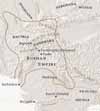 |
==the
Kushan dynasty kings establish themselves across a broad
swath of the western Gangetic plain, the Punjab, and northern
Afghanistan;
their major cities include Kabul (Kapisa), Peshawar (Pushpakalavati),
and
Mathura; the *Kushan
kingdom* lasts throughout the first two centuries CE and remains
strong
until Vasudeva dies in 225. A useful coin study site for this period: *Ancient
Coins Canada*. [*Routes*] |
 |
==Gondophares
and the Indo-Parthian kingdom: Also in Gandhara, the
breakaway
Parthian ruler Gondophares or Gondophernes or (the Indian form)
Guduphara
(r. c.19-47) displaces the Indo-Scythian dynasty, and founds the *Indo-Parthian
kingdom*, which lasts through most of the first century CE. If you
find all these various kings running around in Gandhara a bit
confusing,
you're not alone-- so do I, and so do serious scholars in the field: *Encyclopedia
Iranica*. But look at the terrific ivory carvings from Begram,
Afghanistan:
*DSAL*.
[*Routes*] |
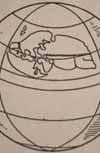 |
==Strabo's
India (c.18-23) is in the southeast corner of the known
world:
The Greek historian Strabo, in his "Geographia" (*Columbia
U.*), tries gallantly to sort out all the accounts he's heard about
India and Taprobane (Sri Lanka). In his (now lost, but plausibly
reconstructed)
map of the world, India juts out from the southeast corner. His famous
work has been called "the sum total of cartographic knowledge before
the
Christian era" (*Henry
Davis*). |
 |
==Saint
Thomas in India (c.46): According to tradition, Saint
Thomas
the Apostle travels to India; the Catholics of Kerala claim him as
their
founding figure. Among other miraculous deeds, he travels to the court
of "King Gundaphorus" (Gondophares?) and eventually converts him to
Christianity.
The story is told in the early Christian text *Acts
of Thomas* (see paragraph 17, "The Second Act"). [*Routes*] |
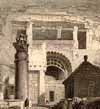 |
==Karle
(c.50-75): This rock-cut Deccani cave temple shows the increasing
complexity of the tradition. Trading networks are prospering, and
merchants
can afford to contribute to these and other expensive temple
construction
projects--which are conveniently located along trade routes.
Inscriptions
at Karle record that seven pillare were contributed by "Yavanas," or
Greek
merchants. Images: *Berger*;
*AIIS
Penn*. [*Routes*] |
 |
==the
Periplus lists the South Indian trading ports (c.60):
Written
by a Greek Alexandrian living in Egypt, "The Periplus of the Erythraean
Sea" (*Internet
Sourcebook*), a guide for merchants, details a trade route that
includes
many South Indian ports of call. During this period Gujarat is the
"fulcrum
of maritime trade on the Arabian sea* (--*Encyclopedia
Iranica*); *wiki*. |
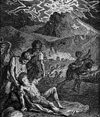 |
==Pliny
dies with Pompeii (79): The Roman naturalist Pliny the
Elder
dies in the eruption of Mount Vesuvius that buries Pompeii in 79. He
leaves
behind a famous "Natural History" completed in 77, with the best
account
of India that he could offer (*Columbia
U.*), and 160 volumes of notes. In his account of Indian trade he
observes
that "the desire for gain brought India nearer," so that merchant ships
make the trip every year, even if they have to keep "companies of
archers"
on board to fend off pirates. |
|
|
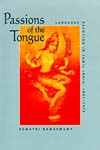 |
==Tamil
begins to develop: During this century various kinds of
literature
in the most important South Indian classical language, Tamil, appear on
the scene. Tamil is a member of the Dravidian language family (*ethnologue*).
Its complex development occurs in mutual give-and-take with Sanskrit,
though
partisans on both sides sometimes seek to polarize the two. In later
times,
it becomes an emblem of cultural identity for which some of its
partisans
are even willing to die. Discussion: *wiki*; *Iravatham
Mahadevan*; *Sumathi
Ramaswamy*; *Outlook*. |
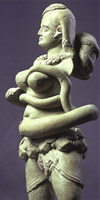 |
==An
unknown Nagini or other goddess (c.00's-100's): Just to
point
up how much we don't know about early Indic art and religion, consider
this powerful, sensual, and enigmatic figure. Who was she? What role,
if
any, did she play in the religious practices of the time? |
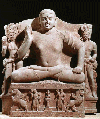 |
==Dharmanandi
dedicates a Bodhisattva (82): This is one of the most
charming,
friendly, amused Bodhisattvas it's possible to imagine. And as he says
in his inscription, Dharmanandi dedicates it together with his parents,
his paternal aunt Bhadra, and "all living beings." |
 |
==The
Jains split into two sects (c.100), the Digambaras
("Sky-clad,"
or naked) (*wiki*) and the
Shvetambaras ("White-clad") (*wiki*). The
former--who are often
considered more pure and conservative--are more prevalent in the south,
the latter in the north and west. |
 |
==Patanjali--
who was he, and when did he live? The author of the "Mahabhasya," a
commentary
on Panini, may have lived in the 200's BCE. Is the author of the
extremely
influential "Yoga-sutras" (*sacred
texts*; *Charles
Johnston*; *indopedia*;
*wikipedia*)
the same person? If not, he may have lived anytime up to the 300's,
depending
on which authority you trust. Here, I'm splitting the difference. |
|
|














